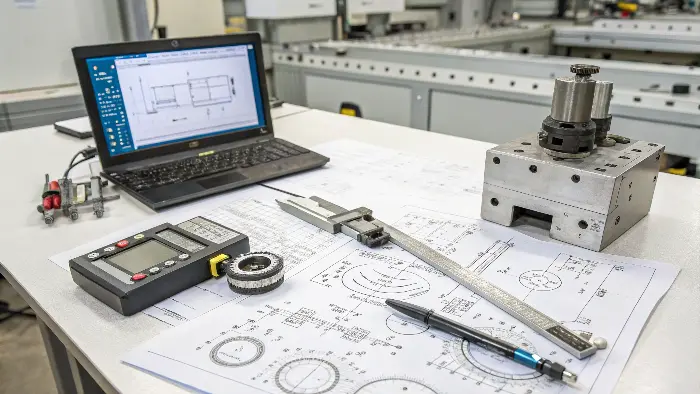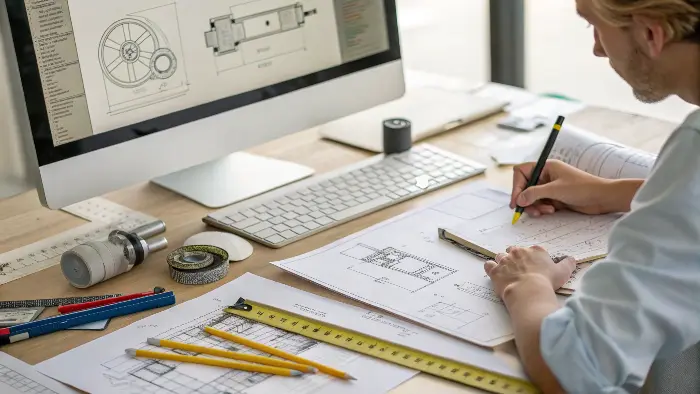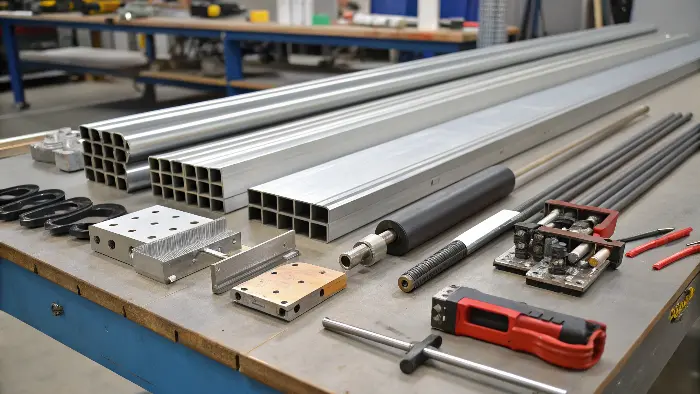Are your CNC machining projects plagued by inconsistent part quality or slow setup times? Relying on general-purpose workholding for every job can seriously hinder your efficiency and precision.
Mastering custom CNC fixture design involves a systematic process: meticulously analyzing part requirements, applying sound engineering principles for locating and clamping, carefully selecting materials, and thoroughly validating the design before manufacturing the fixture itself.
Throughout my career, from my early days on the CNC shop floor to now helping clients worldwide at QuickCNCs optimize their manufacturing, I’ve seen firsthand the transformative power of well-designed custom fixtures. They aren’t just accessories; they are often the unsung heroes that enable precision, speed, and repeatability, especially for complex or high-volume parts. If you’re an engineer looking to truly elevate your manufacturing outcomes, let’s walk through how you can approach custom fixture design step-by-step.
When is a Custom CNC Fixture Truly Necessary for Your Project?
Struggling with inefficient setups or inconsistent part quality using standard clamps? Off-the-shelf solutions don’t always cut it, especially when dealing with complex or delicate parts. Custom fixtures might be your answer.
Custom CNC fixtures are essential for high-volume production runs, parts with complex geometries or tight tolerances, or when standard workholding compromises machine accessibility or workpiece rigidity. They ensure consistent part quality and optimize machining cycle times.
I often get asked by clients, "Do I really need a custom fixture for this part?" It’s a fair question because designing and building one takes time and resources. My answer usually comes down to evaluating a few key factors. While modular systems are great for flexibility, there are situations where the investment in a custom-designed solution pays off significantly.
Key Scenarios Demanding Custom Fixturing:
Let’s look at situations where a custom fixture isn’t just a ‘nice-to-have’ but a critical component for success:
- High-Volume Production: If you’re machining hundreds or thousands of the same part, the time saved per part by using a custom fixture adds up quickly. Quick loading/unloading and optimized toolpaths, made possible by a dedicated fixture, directly impact your overall throughput and cost per part. Shaving even a few seconds off each cycle can mean huge savings over the entire production run.
- Complex Part Geometries: Parts with unusual shapes, contoured surfaces, or features that are difficult to access with standard clamps often require a custom solution. A well-designed fixture can securely hold the part in the precise orientation needed, ensuring all features are machined accurately without interference. I’ve seen many projects where a smart fixture design was the only way to make a complex part machinable.
- Tight Tolerances and High Repeatability: When your parts require very tight dimensional or geometric tolerances (like those Alex, our German engineer profile, often deals with at ±0.01mm), a custom fixture provides superior locating accuracy and rigidity. This minimizes variation from part to part, which is crucial for quality control and assembly downstream.
- Unstable or Delicate Parts: Thin-walled components, fragile materials, or parts prone to distortion under clamping pressure need careful workholding. Custom fixtures can be designed to support the workpiece adequately and apply clamping forces in a controlled manner, preventing damage or deformation.
- Optimizing Cycle Times and Reducing Operations: Sometimes, a custom fixture can allow multiple operations to be performed in a single setup, or even allow multiple parts to be machined simultaneously. This drastically reduces setup time, handling, and the potential for errors introduced by re-fixturing.
If your project ticks one or more of these boxes, investing in custom fixture design is likely a very smart move.What Are the Critical Initial Steps in Designing a Custom CNC Fixture?
Diving into fixture design without a clear, detailed plan? This approach often leads to costly rework, unexpected delays, and a fixture that doesn’t perform as expected. A systematic start is crucial.
Begin by thoroughly analyzing the workpiece drawing and manufacturing process. Clearly define locating surfaces and clamping points, and always consider machine constraints, operator ergonomics, and safety from the very outset.

Before I even think about sketching a fixture or opening CAD software, I spend a good amount of time just gathering information and understanding the problem thoroughly. This initial groundwork is probably the most important phase. A mistake here can ripple through the entire design and manufacturing process of the fixture, leading to wasted time and money.Laying a Solid Foundation:
Here’s a breakdown of what I focus on at the very beginning:
- Thorough Part Analysis:
- Study the Engineering Drawing: Understand all geometric dimensioning and tolerancing (GD&T) callouts, critical features, datums, and material specifications. Which surfaces are being machined? What are the required surface finishes?
- Identify Machining Operations: List all the operations to be performed (milling, drilling, boring, tapping, etc.). Note the sequence of these operations and the cutting tools that will be used. This helps determine tool access requirements.
- Defining the Locating Strategy:
- The 3-2-1 Principle: This is a fundamental concept in fixturing. You need to constrain the workpiece in all six degrees of freedom (three translational, three rotational). Typically, this means:
- Three points define a primary plane (constraining 3 degrees).
- Two points define a line on a perpendicular plane (constraining 2 more degrees).
- One point on a third perpendicular plane fully constrains the part (constraining the final degree).
- Choose Stable Locating Surfaces: Select datum surfaces on the workpiece that are stable, unlikely to vary much from part to part, and ideally, are not machined away in the current setup.
- Determining Clamping Requirements:
- Clamping Force: Estimate the necessary clamping force to securely hold the part against the machining forces without distorting it.
- Clamping Positions: Clamps should act against solid locating points or supports. They should not interfere with cutting tools or obstruct chip flow.
- Type of Clamps: Consider manual clamps, hydraulic clamps, pneumatic clamps, etc., based on volume, speed requirements, and available resources.
- Considering Machine and Operator Interface:
- Machine Compatibility: Will the fixture fit on the machine table? Are there T-slots or tapped holes for mounting? Is there enough Z-axis clearance?
- Chip Evacuation: How will chips be removed? Poor chip control can lead to recutting chips, tool breakage, and poor surface finish.
- Operator Ergonomics & Safety: The fixture must be easy and safe for the operator to load and unload parts. Avoid sharp edges and pinch points. Loading should be intuitive to prevent errors.
Getting these initial steps right makes the rest of the design process much smoother and far more likely to result in a successful fixture.How Do You Develop and Refine the Conceptual Design of Your Fixture?
Got your requirements but unsure how to translate them into a solid, workable fixture design? Moving from a list of needs to a tangible concept requires a structured, iterative approach.
Develop initial concepts through sketching and brainstorming. Then, use 3D CAD software for detailed modeling and iterative refinement. Prioritize simplicity, rigidity, chip evacuation, and ease of loading/unloading parts.

Once I have a solid grasp of all the requirements, the creative part of designing the fixture begins. For me, this often starts with very simple sketches on paper, exploring different ways to locate and clamp the part. It’s about getting ideas out quickly without worrying too much about perfection at this stage. Then, it’s time to move to the precision world of CAD.From Idea to Detailed Design:
Here’s how I approach developing the actual fixture concept:
- Thorough Part Analysis:
- Brainstorming and Sketching:
- Don’t limit yourself to the first idea. Sketch out several different approaches to workholding. Consider different orientations of the part.
- Think about standard fixture components you might be able to use (like toggle clamps, locating pins, etc.) to save time and cost.
- Leveraging CAD for Detailed Design:
- This is where the fixture really takes shape. Model the workpiece accurately in your CAD system first.
- Then, build the fixture components around the workpiece. This allows you to check for clearances, interferences, and tool access in a virtual environment.
- Use the CAD model to precisely place locating pins, rest pads, and clamps according to your defined strategy.
- Ensure all fixture components are robust enough to withstand cutting forces. I often perform quick mental checks or simple calculations for rigidity.
-
Prioritizing Key Design Principles: As you design, constantly evaluate against these principles: Principle My Focus Why It’s Crucial for Success Rigidity Ensure the fixture body and clamping elements are stiff enough to prevent any deflection or vibration during machining. Maintains accuracy, prevents chatter, ensures good surface finish. Accessibility Design so that cutting tools can reach all necessary features without colliding with the fixture. Allows for efficient toolpaths and complete machining of the part. Chip Evacuation Incorporate features like angled surfaces, coolant passages, or open areas to allow chips to fall away easily. Prevents chip buildup, tool breakage, and poor surface quality. Ergonomics Make it easy and safe for the operator to load and unload parts quickly and correctly. Reduces operator fatigue, minimizes errors, improves cycle time. Simplicity Keep the design as simple as possible while meeting all requirements. Fewer parts often mean lower cost and more reliability. Easier to build, maintain, and less prone to failure. This conceptual design phase is iterative. I’ll often go back and forth, tweaking positions, changing component types, and running virtual checks until I’m confident the design is sound, practical, and meets all the initial requirements.
What Material and Component Selection Criteria Are Key for Custom Fixtures?
Worried about your custom fixture wearing out too quickly or not performing under pressure? The right materials and components are absolutely fundamental to a fixture’s longevity, accuracy, and overall performance.
Choose fixture body materials like steel for durability or aluminum for lighter weight. Use hardened tool steel for wear-prone locators and clamps. Utilize standard off-the-shelf components whenever possible to reduce cost and lead time.

Selecting the right materials and components is a critical step that directly impacts how well your custom fixture will perform and how long it will last. I’ve seen fixtures fail prematurely simply because the wrong material was chosen for a critical locating surface, or because a standard component was overlooked in favor of a more expensive, custom-made part.Making Smart Choices for Durability and Cost:
Here’s what I consider when specifying materials and components for a custom CNC fixture:
- Fixture Body Material:
- Steel (e.g., 1018, 4140 Pre-Hardened): Offers excellent rigidity, durability, and wear resistance. Good for high-load applications or when the fixture will see a lot of use. It’s heavier, which can be a consideration for larger fixtures.
- Aluminum (e.g., 6061-T6, 7075-T6): Lighter weight, making it easier to handle, especially for larger fixtures or those frequently moved. Easier and faster to machine. Good for many applications, but less wear-resistant than steel unless critical surfaces are made from inserts.
- Tool Steel (e.g., A2, D2): Used for specific elements like locators or wear pads that require high hardness and wear resistance. Often inserted into a softer fixture body material.
- Locating and Clamping Elements:
- Hardened Steel: Essential for locating pins, rest buttons, and clamp faces that experience repeated contact and wear. This maintains accuracy over the life of the fixture.
- Bronze or Brass: Sometimes used for clamping elements when machining delicate parts to prevent marring the workpiece surface.
- Standard vs. Custom Components:
- Leverage Standard Components: I always try to incorporate commercially available fixture components like toggle clamps, swing clamps, dowel pins, shoulder screws, and rest pads. Companies like Carr Lane, Jergens, or Misumi offer a vast catalog. This significantly reduces design time, manufacturing cost, and lead time for the fixture. It also makes replacement easier.
- Custom Components: Only design and fabricate custom components when a standard item simply won’t do the job or fit the specific geometric constraints of your part.
- Surface Treatments and Hardness:
- Consider heat treatment (hardening and tempering) for steel components that will experience high loads or wear.
- Surface coatings like black oxide can provide corrosion resistance and some minor wear improvement.
Making informed decisions here means your fixture will not only perform well initially but will continue to do so reliably over many production cycles. For an engineer like Alex, specifying hardened tool steel locators for his high-tolerance robotic components would be a non-negotiable aspect of the design to ensure long-term precision.Conclusion
Custom CNC fixture design is a key skill. It ensures precision, boosts efficiency, and cuts costs in manufacturing. Follow these steps for better results.


